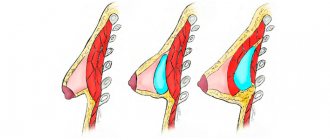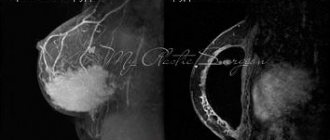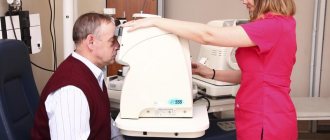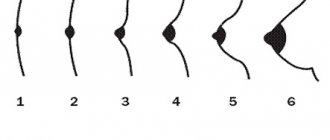Why are breasts asymmetrical?
A slight deviation in the size and shape of the left and right breasts is normal. We can talk about a problem when the difference is significant and is measured in one or even two sizes, requiring constant efforts to harmonize the figure with the help of special underwear (this is called true asymmetry).
There can be many reasons. Breast asymmetry is caused by:
- Postural disorders and scoliosis
- Unilateral breast underdevelopment
- Unilateral hypertrophied condition of the mammary gland
- Drooping of the breast (ptosis)
- Hormonal imbalances in adulthood (for example, during pregnancy) with uneven enlargement of the mammary glands
- Incorrect breastfeeding (in which the baby often suckles on one breast)
- Chest injuries
Breast asymmetry
Taking into account the difference in the size of the mammary glands, plastic surgery distinguishes three degrees of breast asymmetry: mild (the differences between the mammary glands are insignificant and do not require surgical intervention), moderate (one mammary gland is 1/3 larger than the other), severe (one mammary gland is larger than the other by 1/2). In clinical practice, various types of breast asymmetry may occur (in terms of volume, shape, degree of ptosis, position of the nipple and areola), requiring different tactics.
Breast hypoplasia is manifested by delayed development of one mammary gland while the other is normally developed. In this case, to correct breast asymmetry, the patient may require endoprosthesis replacement of the smaller breast with a silicone implant. The opposite situation is observed with mammary gland hypertrophy, when there is excessive enlargement of one breast and normal development of the second. Tactics for this type of breast asymmetry will include reduction mammoplasty - reduction of the larger mammary gland. It is possible that there is hypoplasia of one breast and hypertrophy of the other - in such cases, the smaller mammary gland is enlarged and the hypertrophied one is reduced.
Asymmetry of breast shape can manifest itself in the following ways: the tubular structure of both mammary glands, equal in volume; tubular structure and reduction of one breast or tubular structure and enlargement of one breast. Tubular mammary glands are spoken of when the breast does not have the shape of a hemisphere, but an elongated tube (“proboscis”), topped with a stretched areola. With tubular glands, their shape and size are changed without or with the use of implants.
The asymmetry of the position is expressed in the following possible options: descent of both mammary glands to different levels; prolapse of one breast. For mastoptosis, a breast lift (mastopexy) is performed using a periareolar, T-shaped, vertical or L-shaped approach. Sometimes endoprosthetics or breast reduction are performed simultaneously with mastopexy.
In addition to disproportion in the size, shape and position of the mammary glands, breast asymmetry can be manifested by unequal diameter of the areolas or the shape of the nipples, requiring correction of the nipple-areolar complex.
Severe and noticeable breast asymmetry gives rise to various psychological disorders in a woman, creates difficulties in choosing beautiful and elegant underwear, and causes discomfort when visiting the beach, bathhouse, sauna, or swimming pool. Often, breast asymmetry becomes an obstacle to entering into intimate relationships, since a woman develops an insurmountable fear of showing off her naked body.
How to avoid the development of asymmetry?
First of all, carefully monitor your breasts - and if you notice a size difference during puberty, consult a doctor. Sometimes hormonal therapy can minimize the risk of developing asymmetrical breasts.
The general rule has become the mandatory wearing of supportive underwear, even if the breasts are very small - this will avoid sagging (which, like everything in nature, is rarely uniform).
It is especially important to pay attention to the breasts during pregnancy and lactation. At this time, the breast is undergoing serious changes: the structure of the gland changes, the breast begins to fill with milk and empty, in a word, traumatic factors are present. And although breastfeeding is a natural process, women often pay for it with asymmetrical breasts. This often happens when the child latches unevenly - almost every baby has a “favorite” breast. It is more traumatized during feeding and, as a result, it sags more over time. Therefore, if you are breastfeeding, be sure to wear special underwear and try to correctly alternate between the left and right breasts when feeding.
What to do if your breasts are of different sizes, can you correct the defect yourself?
Correction techniques vary depending on the degree of asymmetry. For mild cases, correction can be done independently. To do this, they perform special physical exercises, massage, and use cosmetics. Usually the defect can be successfully hidden with corrective underwear. Moderate and severe degrees require surgical intervention. This can be mastopexy, implantation, reduction plastic surgery and other types of mammoplasty. If the asymmetry is small, then lipofilling is possible, that is, fat is extracted from the patient’s problem area, which, after cleaning, is injected into the smaller mammary gland. Unfortunately, this technique is not suitable when there are differences in the shape, outline of the areolas, and the direction of the nipples.
How to get rid of asymmetry
There are several ways to remove asymmetry, but the choice depends on its degree. In addition, for greater effect, the necessary procedures can be carried out separately or in combination. But first you need consultation with specialists, namely a mammologist and a surgeon.
Methods used in practice:
- breast lift (mastopexy);
- silicone implants;
- lipofilling (involves the process of adjusting the breasts using a woman’s own fat; it is used infrequently and with a low degree of asymmetry, as well as if there is no ptosis).
Will correcting breast asymmetry affect my ability to breastfeed?
Cases may vary, but in general, mothers can breastfeed after breast asymmetry is corrected. However, for some women, after surgery to correct breast asymmetry, sensation in the nipples is reduced, making it more difficult to trigger the reflex that causes milk to come down. Some women may also experience a decrease in milk supply. If you plan to breastfeed after surgery to correct breast asymmetry, talk to your plastic surgeon to get information directly about your surgery.
Causes of asymmetry after surgery
According to statistics, different breast sizes after mammoplasty are diagnosed in 7 out of 100 operated women. At risk are patients with congenital asymmetry, which was practically invisible externally before surgery. In such cases, the surgeon’s initial task is to consider the possibility of installing implants of different sizes.
Different breast volumes after mammoplasty are possible due to incorrect placement of the implant by the doctor: a pocket for the implant was made too large, which caused its displacement. Or a capsular contracture has formed around the implant - a dense fibrous membrane, causing deformation. This is possible due to the predisposition of the patient’s body and should be identified at the stage of determining contraindications.
One breast is higher than the other after mammoplasty may be due to the use of low-quality implants that do not stay in the pockets, are pressed through, dislocated and migrate. To minimize risks, choose certified, clinically tested implants and a qualified, reputable plastic surgeon.
Failure by the patient to comply with the doctor’s recommendations - early refusal of compression garments, sleeping on the stomach, early physical activity - are quite common causes of breast asymmetry after mammoplasty.
What are the potential risks and complications?
Modern surgery is generally safe, but potential risks always exist. Some of the problems associated with surgery to correct breast asymmetry may include:
- bleeding or infection
- seromas and hematomas
- noticeable scars due to stretching and lengthening
- noticeable scars due to keloidosis
- allergic reactions to medications, patches and suture material
- pigmentation or skin lightening
- impaired blood supply to the skin and necrosis
- impaired sensitivity of gland areas
- impaired sensitivity of the nipples and areolas
- unevenness and ripples above the implant
- capsular contracture (fibrous capsule around the implant)
- unsuitable implant size
- implant rupture
- inability to breastfeed
How is the operation performed?
Before surgery, the patient undergoes an examination, takes tests, and receives consultation from an anesthesiologist, therapist, and plastic surgeon. The operation can last up to 3 hours, depending on the tasks assigned to the doctor. General anesthesia is used. The techniques differ: it is possible to enlarge one or two mammary glands with implants, or reduce (reduce), combined with a lift, the larger breast, or both. After the intervention, the patient remains under the supervision of doctors in the hospital for an average of 24 hours. The rehabilitation period can last up to a month. In the first days there is pain, which must be relieved only with the drug prescribed by the doctor. The stitches are removed after 1-2 weeks. It is necessary to wear compression garments for about a month to stabilize the results.
Chest pain - be careful!
For many women, before menstruation, the breasts become swollen, heavy and painful. This is due to sensitivity to hormonal changes. Relief from symptoms can be obtained by wearing a soft bra at night, avoiding strenuous exercise before menstruation, and stopping hormonal medications (oral contraceptives or hormone replacement therapy). There are opinions that caffeine worsens chest pain, so you should avoid coffee and Coca-Cola.
Very severe chest pain can be treated hormonally by reducing the concentration of prolactin (a hormone that stimulates the growth of glandular tissue in the breast). However, this therapy is associated with unpleasant side effects (nausea, pain and dizziness). There are reports that rubbing ibuprofen (non-steroidal anti-inflammatory drug) gel on the chest can help relieve pain. But this can only be done as prescribed by a doctor.
Chest pain not associated with the menstrual cycle, acute, burning in nature, is usually the result of injury, infection (abscess, shingles), Tietze's syndrome, pleurisy and other diseases. There is a small chance that this pain is due to cancerous changes, so you should consult your doctor.
What other implant-related issues should I consider?
There are claims that breast implants are associated with the development of connective tissue diseases such as rheumatoid arthritis, SLE (lupus erythematosus), scleroderma and similar autoimmune conditions. Although some studies suggest an increased risk, most medical studies have shown that implants do not increase the risk of these problems. Breast implants do not increase the risk of breast cancer. If breast cancer is detected in women with prosthetic breasts, then, as a rule, the recovery rate is higher in the early stages. This is due to these women taking more careful care of their health.
The cost of breast correction surgeries in our clinic.
The cost is formed according to the basic price list for a specific operation. The cost of a breast lift or prosthesis for one breast is usually 2/3 of the cost of a bilateral operation. The cost of the implant is discussed separately and depends on the manufacturer. In recent months, due to strong changes in the ruble exchange rate, prices for implants and other foreign materials have increased significantly in price, which has led to an increase in the cost of treatment.
In the clinic’s price list, the cost of any operation is presented in the price range from... to...
The spread is quite wide and affects the upper part of the low price range, the middle and high price categories. The purpose of this proposal is to provide the opportunity for anyone who wishes to undergo treatment. All the clinic’s specialists dealing with breast problems have sufficient training and experience, are well versed in the topic and can be recommended by me without fear. The distribution of surgeons into price categories is not a matter of quality or safety, which are equally high, but a matter of my personal decision. Therefore, the patient can safely choose a surgeon according to his liking or his personal preferences. In any case, the entire treatment process is under my control, and you can contact me personally at any time.










